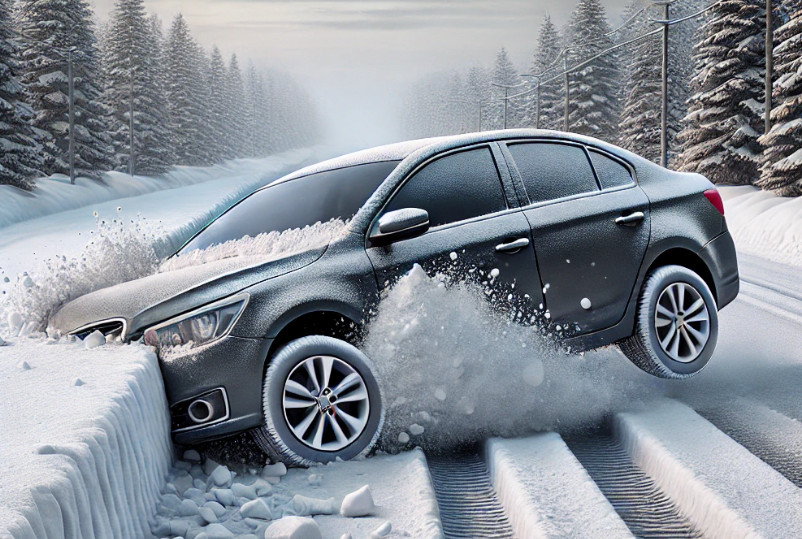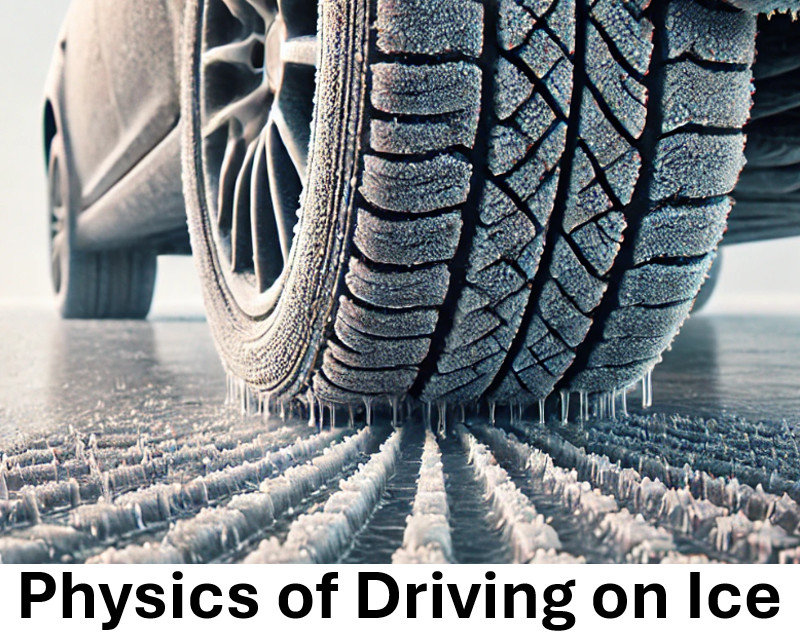Few things are as nerve-wracking—or entertaining to watch in fail videos—as driving on ice. The treacherous mix of reduced friction, temperature-sensitive tires, and the occasional overconfidence of drivers creates a perfect storm for physics in action. Let’s explore the physics behind driving on ice, why winter tires are essential, and how chains give you a fighting chance on those slick surfaces.
Friction: The Key Player (Or the Lack Thereof)
Driving on ice is like trying to sprint on a soapy floor—you’re bound to lose your footing. This happens because ice drastically reduces the coefficient of friction, the measure of how much grip exists between your tires and the road. On a dry road, the coefficient of friction might be around 0.7 or higher, but on ice, it can drop close to 0.1.
This lack of friction explains why your car seems to take a leisurely glide rather than a controlled stop when you hit the brakes. Instead of gripping the road, your tires slide, sending your car into a skating routine it wasn’t designed for. Want to learn more about friction? Check out the Stickman Physics page on friction.
Why Winter Tires Matter
Regular tires are made of rubber compounds that harden in cold weather, reducing their ability to grip the road. Winter tires, however, are made with softer rubber that stays pliable in freezing temperatures, allowing them to maintain contact with the road.
But that’s not all—winter tires also have deeper treads and unique patterns designed to channel snow and water away, increasing traction. Imagine trying to grip a slippery floor with ballet shoes versus spiked cleats; that’s the difference between regular and winter tires on icy roads.
Chains: The Armor for Your Tires
When conditions get particularly icy, tire chains are like strapping crampons onto your car. Chains dig into the ice, creating small grooves that increase the coefficient of friction. However, they only work well in thick snow or ice; using them on dry pavement can damage both your tires and the road.
Now, picture this: You’re driving with tire chains, and the chains somehow break free mid-drive. Instead of gripping the road, the chains become lethal spaghetti, slapping everything in their path. That’s why proper chain installation is critical—not just for physics, but for survival.
Sliding and Stopping: The Physics of Braking
The reason braking on ice feels like you’re auditioning for a figure skating competition comes down to inertia and kinetic friction. When you brake on a normal surface, friction helps stop the wheels. On ice, however, kinetic friction is so low that your car keeps moving forward.
Anti-lock braking systems (ABS) help by preventing the wheels from locking up, maintaining some degree of traction. Without ABS? You might as well be driving a sled. For a refresher on kinetic friction, visit the Stickman Physics page on kinetic friction.
Momentum and Turning: Why Skidding Happens
When you turn on ice, your car’s momentum often decides to keep going straight, regardless of where you point the wheel. This is because the frictional force required to change direction is greater than what the ice can provide. This phenomenon, known as understeering, is why so many cars end up in ditches during winter storms.
Now, imagine overcorrecting—a situation ripe for oversteering, where your car spins like a top. Congratulations, you’ve just turned physics into an expensive and scary carnival ride.
What Happens When Physics Goes Awry

Picture this: You’re driving to the grocery store on an icy day. You hit the brakes gently, but instead of stopping, your car slides straight past the parking lot and into a snowbank. Not wanting to abandon your dignity, you reverse out and try again—only this time, your winter tires grip, and you slam into the cart return. Physics always wins.
1. Slow Down
Why It Works:
When driving on icy roads, your stopping distance can increase dramatically because of the lower coefficient of friction. On a dry road, the coefficient might be around 0.7, but on ice, it can drop to 0.1 or less. By reducing your speed, you decrease your momentum (p=mv), making it easier to bring your car to a controlled stop using the limited friction available.
2. Use Winter Tires or Chains
Why It Works:
Winter tires are made with softer rubber compounds that remain pliable in cold temperatures, ensuring better contact with the road. They also have deeper tread patterns to channel snow and water away, increasing grip. Chains take it a step further by physically digging into the ice, increasing traction. This improves the frictional force acting against your car’s motion, allowing for safer starts, stops, and turns.
3. Avoid Sudden Movements
Why It Works:
Abrupt actions can overwhelm the already limited friction between your tires and the ice. For example, slamming the brakes locks the wheels, causing kinetic friction to take over, which is weaker than static friction. Smooth braking allows static friction to remain in play, giving you more control over your vehicle.
4. Turn Into Skids
Why It Works:
If your car starts to skid, turning into the skid can help realign your tires with the direction of your car’s momentum. This reduces sideways slipping caused by the mismatch between your car’s inertia and the available traction force. This technique leverages Newton’s First Law, which states that objects in motion will stay in motion unless acted upon by an external force—in this case, friction.
5. Increase Following Distance
Why It Works:
The reduced friction on icy roads means your car requires significantly more time and space to come to a complete stop. Increasing your following distance allows both you and the car ahead more time to react, reducing the likelihood of collisions.
The stopping distance (x) can be calculated using the following equation, where the final velocity (vf) is 0 m/s, the initial velocity (vi) is known, and the deceleration (−a) is applied:
The deceleration (-a) depends on the net force (Fnet) and the mass (m) of the car, as described by Newton’s Second Law: Fnet=ma. On icy roads, the only force acting to stop your car is the force of friction (Ff). This force can be determined using the formula:
where μ is the coefficient of friction and FN, the normal force, equals the weight (Fg) of the car (Fg = mg) on a horizontal surface.
The lower coefficient of friction on ice drastically reduces the stopping force, meaning your car requires a much greater distance to stop compared to dry roads. This is why driving slower and maintaining a safe following distance are essential in icy conditions.
6. Use Low Gears on Hills
Why It Works:
Using low gears prevents your wheels from spinning too quickly when climbing or descending a hill. This allows for better grip by ensuring that the torque (rotational force) applied to the tires doesn’t exceed the frictional force needed to maintain traction.
7. Plan Your Stops
Why It Works:
Anticipating stops well in advance and braking gradually reduces the force needed to bring your car to a halt. Sudden stops can lead to skidding, where the frictional force becomes too weak to counteract your car’s inertia.
Disclaimer:
Always prioritize your safety and avoid driving in icy conditions unless absolutely necessary. These tips are meant to help, but they cannot eliminate all risks. Always drive cautiously and stay informed about weather and road conditions.
Conclusion: Mastering the Ice
Driving on ice isn’t just a battle against nature—it’s a delicate dance with physics. Understanding friction, momentum, and the role of specialized equipment like winter tires and chains can make the difference between a safe drive and a viral fail video.
For more on the science behind friction and motion, visit Stickman Physics. And next time you’re out on an icy road, remember: physics doesn’t care about your confidence—it only cares about the math.

